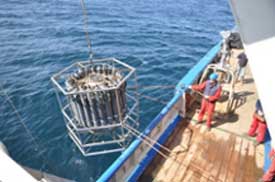Imbalance in Phosphorus and Nitrogen Levels in the North Sea Caused by Environmental Policy

In recent decades, European environmental policy has aimed to improve water quality through the reduction of nitrogen and phosphorus loads in surface waters. The measures taken were much more effective at the removal of phosphorus than nitrogen, resulting in a large imbalance of these two nutrients. Scientists from the University of Amsterdam (UvA) and the NIOZ Royal Netherlands Institute for Sea Research (NIOZ), led by Prof. Jef Huisman, have now demonstrated that the unbalanced nutrient reduction has caused a major shortage of phosphorus in coastal waters of the North Sea.
Nitrogen and phosphorus are essential building blocks for life. Historically, the concentrations of these nutrients have shown major changes in surface waters. Due to intensified agriculture and the use of phosphate additives in detergents, the input of nitrate and phosphorus sharply increased between the 1960s and 1980s, which resulted in harmful algal blooms, anoxia and fish kills in lakes and coastal waters. In recent decades, policy measures have been implemented to reduce the discharge of nutrients, but the overall reduction of nutrients was much more successful for phosphorus than for nitrogen.
Samples being taken from the research ship Pelagia in the North Sea (photo: Maayke Stomp, UvA)
The researchers confirmed this by on-deck experiments, where small supplements of phosphorus caused explosive growth of algae. Not all species, however, showed similar responses. The good news is that foam-producing algae grow less well under phosphorus limitation. Unfortunately, the experiments indicate that dinoflagellates, some of which are potentially toxic and bloom-forming species, may profit from decreasing levels of phosphorus. Furthermore, the phosphorus content of the algae themselves was extremely low. According to Burson, algae from the North Sea therefore form a poor nutrient diet for zooplankton and shellfish, although the impact on higher trophic levels in the food web is still unknown.
This research was funded by the national program Sea and Coastal Research (ZKO) of the Netherlands Organization for Scientific Research (NWO).

